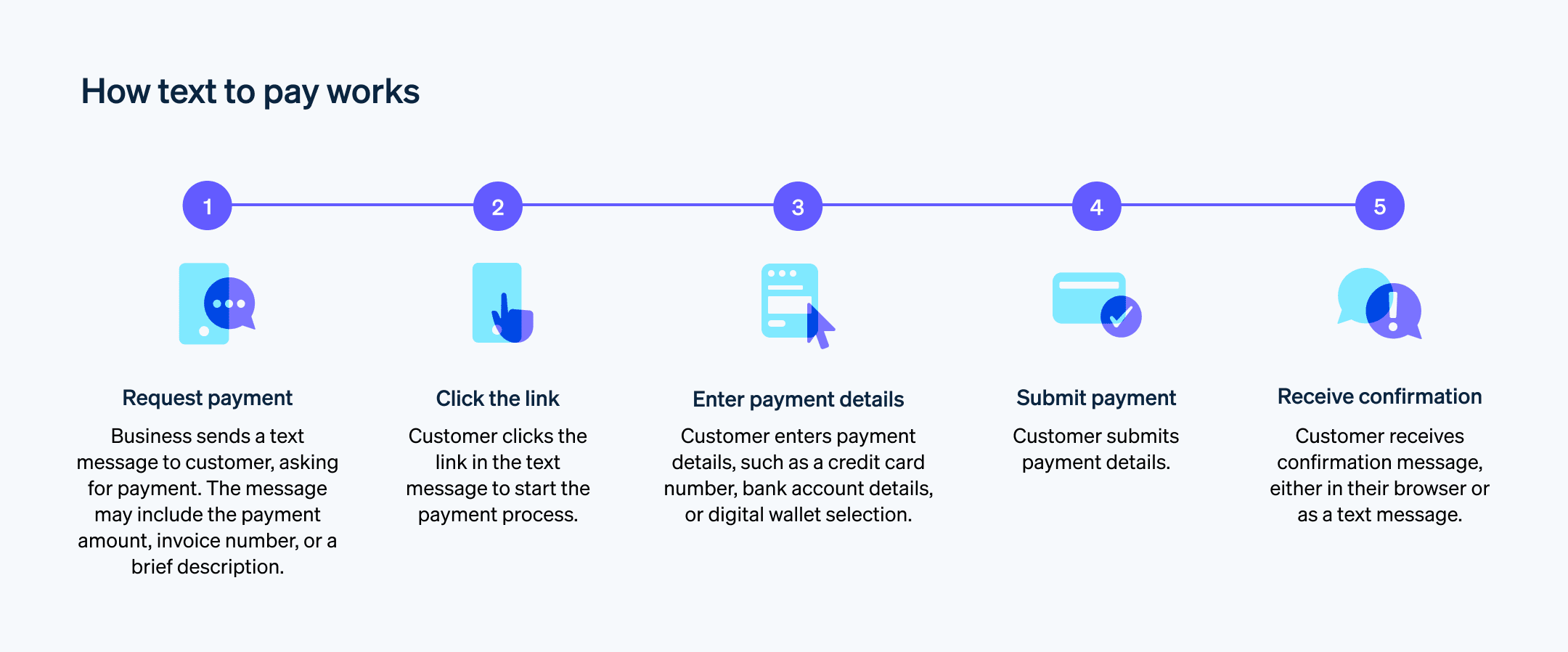短信支付是一种支付方式,企业通过短信发送账单,客户使用移动设备付款。这种技术简化了支付流程,客户可以通过手机进行支付,而无需登录单独的支付系统。这种方法方便快捷,深受企业和消费者的欢迎:SimpleTexting 公司 2023 年的一项研究发现,71% 的美国消费者已注册接收企业短信,这表明客户对短信支付服务的接受程度可能很高。这种方法通常在短信中使用一个安全链接,引导客户进入支付界面,输入信用卡 信息等支付细节,完成交易。该系统可减少计费和付款所花费的时间,从而使企业和客户都受益。
下面,我们将介绍短信支付的运作方式,包括哪些企业可以从中受益最多,以及为企业制定短信支付策略的详细信息。以下是您应该了解的内容。
目录
- 短信支付如何运作?
- 哪些类型的企业使用短信支付?
- 企业接受短信支付的利弊
- 如何制定适合企业需求的短信支付策略
- 短信支付的实施和使用成本是多少?
短信支付如何运作?
短信支付将账单和支付流程整合到一个移动友好的平台中,从而简化了交易。以下是短信支付的运作方式:
通过短信请求付款
企业向客户的手机 发送短信,通知客户付款到期,从而启动该流程。这条简洁的短信通常包括付款金额,也可能提供简要说明或发票号码供参考。短信的目的是提供足够详细的购买信息,而不会让客户不知所措。安全支付链接
短信包含一个链接,客户可以点击该链接启动付款流程。此链接将客户定向到安全付款 门户,该门户通常针对移动设备进行了优化,以方便使用。该链接使用加密 和其他安全措施,以保护客户的个人和财务信息。输入付款信息
付款页面提示客户输入其付款详细信息,例如信用卡 信息、银行账户详细信息或数字钱包 选择。客户输入这些信息的界面设计简单直观。安全协议对数据进行加密并防止未经授权的访问。确认和收据
客户提交付款详细信息后,交易将立即处理。客户会在同一付款页面上收到一条确认信息,同时还会收到一条后续短信。第二条短信作为数字收据,确认了支付金额和收款人。企业则会收到客户付款的通知,以便更新记录。
这个过程代表了向更直接和即时的计费方式 的转变,这也反映了客户以移动设备为中心的习惯。短信支付使客户更容易及时结算账单,帮助企业改善应收账款和整体服务。

哪些类型的企业使用短信支付?
许多企业使用短信支付。这些包括:
公用事业和服务提供商
提供水、电、电信等基本服务的企业经常使用短信支付进行按月计费。这种方法确保了及时收款并减少了对纸质账单的需求。卫生保健设施
医疗机构、诊所和医院使用短信支付来收取所提供服务的付款。对于患者来说,这是一种无需致电提供者或使用纸质邮件即可支付账单的便捷方式。零售商店
零售商,尤其是那些拥有线上店面 的零售商时使用短信支付作为其客户进行快速轻松付款的选项。这些购买通常与订单确认文本相关联。餐厅和餐饮服务
一些餐馆和送餐服务使用短信支付来实现便捷的感应式支付。交通服务
出租车公司和拼车服务使用短信支付让客户使用手机支付乘车费用。通常,这些企业将此功能集成到其移动应用系统中。保险公司
保险公司使用 短信支付来收取保费,使客户无需通过电话或邮件支付的传统方法即可维护他们的保单。物业管理公司
居民可以通过短信支付租金和其他与房产相关的费用,简化了房东和租户的流程,并提供了数字付款记录。政府实体
一些政府机构已采用短信支付来收取费用和罚款,从而提供更现代的支付解决方案。
这些企业和组织通过降低管理成本、缩短付款周期以及减少逾期或错过付款,从短信支付中受益。短信支付的便利性还可以为以移动设备为中心的生活方式的客户带来更高的客户满意度。
企业接受短信支付的利弊
当企业采用短信支付时,它强调快速和简单的交易。SimpleTexting 的 2023 年调查显示,近 81% 的美国消费者在收到短信后五分钟内查看他们的短信通知。向客户提供短信支付服务体现了客户对即时移动交易的重视。
使用短信支付具有许多优势,但也带来了一些挑战。以下是两者的概要:
对企业的好处
交易速度:短信支付的即时性可将账单与付款之间的时间间隔缩短至片刻,与现代商务保持同步。
客户体验:这种方法为客户提供了一键式解决方案,完全适合他们的日常数字工作。
付款及时性:短信的直接推动可以消除混乱,促使及时付款,使收入周期更加顺畅。
节省运营成本:过渡到数字化支付 收款方式比传统的开单方式更有效率,还能减少对纸张和邮资的需求。
审计效率:交易的数字化跟踪简化了审计流程,将记录整合到易于浏览的分类账中。
可访问性:短信支付使企业能更广泛地吸引潜在客户。
对企业的不利因素
技术依赖:短信支付的前提是客户具备并愿意使用移动技术进行金融交易,但并非所有客户都是如此。
安全要求:短信支付交易需要强化网络安全战略,防范数字数据交换中固有的漏洞。
基础设施投资:短信支付需要前期投资,以创建一个强大且用户友好的支付平台,并持续维护以保持有效运营。
计费的准确性:必须对计费自动化进行精心编程,以避免计费不准确的后果,因为这会削弱信任度和客户忠诚度。
监管驾驭:企业必须保持灵活性,以遵守金融部门的法规。
适应障碍:一些细分市场可能会固守传统支付方式,对新的数字环境持怀疑态度或拒绝参与。
采用短信支付不仅是功能上的升级,也是企业以更高的方式与客户互动的战略选择。然而,企业必须深思熟虑地实施这种新的支付方式,并考虑到这种系统所要求的安全性和复杂性。
如何制定适合企业需求的短信支付策略
制定适合您业务目标的短信支付策略需要根据您的运营和客户互动情况采取一系列步骤。以下是分步指南:
评估客户习惯:要确定短信支付是否适合您的企业,请研究客户当前的支付方式以及他们对新技术的开放程度。
定义目标:清楚地说明您希望通过短信支付实现的目标。这可能包括加快支付速度、改善客户体验、减少行政工作等。
选择合适的提供商:选择一个能提供短信支付的支付平台,该平台无论在规模还是交易量上都要适合您的业务。仔细检查支付服务商的安全措施、可靠性和支持服务。
与现有系统集成:短信转支付解决方案应该与您当前的计费软件配合使用,帮助您管理付款和维护记录,而无需手动输入。
设置基础设施:投资于支持短信支付的技术基础设施,例如安全的互联网连接和符合支付卡行业标准。
编写清晰的信息:为您的付款请求制作直接而简洁的消息。其中应包含应付金额和有关如何付款的简单说明。
培训您的团队:确保您的员工了解短信支付的运作方式,并且他们可以协助客户进行咨询。
测试系统:在广泛推广短信支付之前,先进行试点测试以解决任何问题。
启动和教育:向客户介绍短信支付,突出服务的易用性和安全性。提供指南或常见问题解答,指导客户如何使用新的支付方式。
收集反馈:实施后,收集客户反馈,了解客户对服务的接受程度,并做出必要的调整。
监控和适应:监控交易量和客户反馈。在进一步了解哪些对客户有效,哪些无效时,做好调整策略的准备。
经过深思熟虑的短信支付策略需要精心策划,并愿意在必要时进行调整。成功的实施可以为客户提供更及时的付款和更好的付款体验。
短信支付的实施和使用成本是多少?
实施和运营短信支付系统的成本可能会有很大差异,具体取决于多种因素,包括企业规模、交易量以及您选择的特定服务商。
实施成本
- 设置费:一些服务商会收取初始费用来设置短信支付服务,其中可能包括将其与您现有的计费系统集成。
- 技术投资:如果您当前的系统无法支持短信支付,则可能需要投资升级硬件或软件。
- 合规成本:为了安全地处理支付信息,您可能会产生与遵守支付行业安全标准相关的费用。
运营成本
- 交易费用:服务商通常对每笔交易收取费用。这可以是交易金额的百分比、固定费用或两者的组合。
- 月费:使用短信支付平台可能需要支付经常性月费,月费根据您选择的服务和功能级别而有所不同。
- 维护费:为使系统有效运行而进行的持续维护和技术支持也会增加运营成本。
额外费用
- 支付处理费:这是由银行或信用卡 公司收取的付款处理费用,与短信支付服务商收取的交易费不同。
- 营销成本:您可能需要花钱开展营销活动,让客户了解新的支付方式。
决定是否实施短信支付的企业需要将这些成本与预期收益(如更快的支付速度和更高的客户满意度)相比较。最好对不同服务商的价格和服务进行比较,以找到最能满足您特定需求的解决方案。
例如,在 Stripe 中,Payment Links 是标准定价模式的一部分,因此创建和使用 Payment Links 接受付款不会产生额外费用。当您使用 Payment Links 以及其他 Stripe 服务(例如经常性付款的开票或 Stripe Tax)时,这些服务的通常费用适用于任何其他交易类型。在使用 Stripe 服务的基础上,使用 Payment Links 不会产生额外费用。
本文中的内容仅供一般信息和教育目的,不应被解释为法律或税务建议。Stripe 不保证或担保文章中信息的准确性、完整性、充分性或时效性。您应该寻求在您的司法管辖区获得执业许可的合格律师或会计师的建议,以就您的特定情况提供建议。